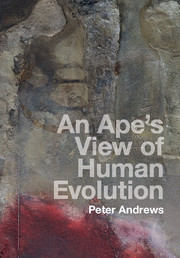Book contents
- Frontmatter
- Contents
- Preface
- 1 How can we recognize common ancestors?
- Part I Apes: their morphology and behaviour
- PART II Environments and palaeoenvironments
- Part III Review of fossil apes
- 7 The view from the early Miocene
- 8 The environment in the early Miocene
- 9 The view from the middle Miocene
- 10 Specialized apes from the middle Miocene
- 11 The environment during the middle Miocene
- 12 A second view from Europe
- 13 The environment in Europe
- 14 Late Miocene to Pleistocene apes
- 15 Apes, hominins and environment in the late Miocene
- Part IV Last common ancestor
- References and further reading
- Index
- References
14 - Late Miocene to Pleistocene apes
from Part III - Review of fossil apes
Published online by Cambridge University Press: 05 January 2016
- Frontmatter
- Contents
- Preface
- 1 How can we recognize common ancestors?
- Part I Apes: their morphology and behaviour
- PART II Environments and palaeoenvironments
- Part III Review of fossil apes
- 7 The view from the early Miocene
- 8 The environment in the early Miocene
- 9 The view from the middle Miocene
- 10 Specialized apes from the middle Miocene
- 11 The environment during the middle Miocene
- 12 A second view from Europe
- 13 The environment in Europe
- 14 Late Miocene to Pleistocene apes
- 15 Apes, hominins and environment in the late Miocene
- Part IV Last common ancestor
- References and further reading
- Index
- References
Summary
Up to this point, we have had the advantage of dealing with relatively well-preserved fossil apes. In the early Miocene we had the partial skeletons of proconsulids, and in the middle Miocene we had either partial skeletons of afropithecines in Africa or very large samples of teeth and jaws with fascinating environmental contexts in Turkey. The later middle Miocene and late Miocene fossil dryopithecines in Europe are equally well preserved, with several skulls and partial skeletons. Late Miocene apes in Africa, by contrast, are poorly represented in the fossil record, but because they are the only fossil apes known in Africa during the late Miocene, they are of some importance. Most apes disappeared from the fossil record by about 8 million years ago, including those previously living in Europe and Asia, although we can mention the giant fossil ape Gigantopithecus blacki, which survived well into the Pleistocene in China and Vietnam. The teeth of this fossil ape has some parallels with human teeth, for example the small incisors and canines, and bicuspid premolars completely lacking any premolar honing, but there is little doubt that these similarities were due to convergence and do not indicate significant evolutionary relationship with humans.
Late Miocene apes in Africa
The three fossil apes in Africa during the period 9 to 10 million years ago are too incomplete to be able to assign them either with each other or to any living or fossil ape. They share few similarities with the great ape and human clade, and in the absence of cranial, dental and postcranial characters such as are present for the dryopithecines, and which link them with the great apes, it is impossible at this stage to assign them to this or any other clade.
In 2007, a fossil ape named Chororapithecus abyssinicus was named from 10 million-year-old deposits at Beticha in the Chorora Formation in Ethiopia. There are only nine isolated teeth, but they showed that it had gorilla-sized dentition and combined a degree of shearing crest formation on the molars with thickened enamel and relatively flat dentine surfaces, an unusual combination not seen in any living or fossil ape. In combination with the thickened enamel, this suggests a functional adaptation to hard and/or abrasive food items.
- Type
- Chapter
- Information
- An Ape's View of Human Evolution , pp. 211 - 218Publisher: Cambridge University PressPrint publication year: 2016



